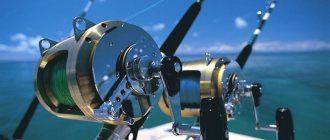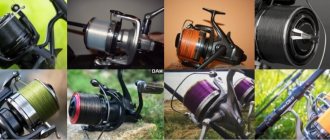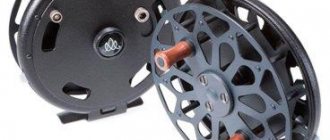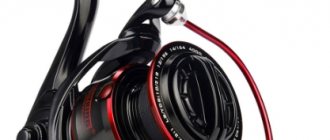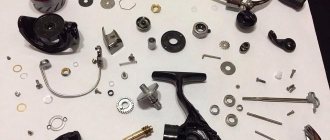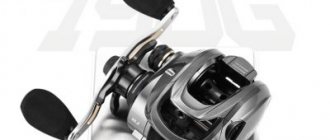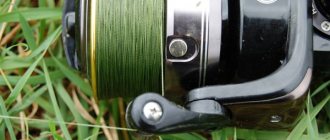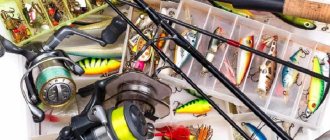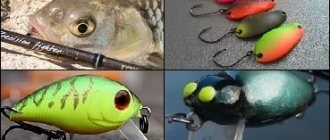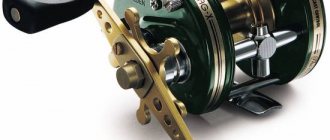How to set up a baitcasting reel
When mastering spinning fishing, beginners timidly look at the multiplier and prefer a classic spinning reel. Their point of view is clear - the complexity of the design, some additional weights, brakes, at a time when in an inertia-free system I simply opened the bracket and threw it.
At the same time, an angler who has mastered a baitcasting reel is unlikely to return to the “meat grinder”. This is explained simply - the colossal sensitivity of a bite in the hand overcomes all the mythical difficulties when fishing with a multiplier. In addition, in order to fish without any problems with a multiplier reel, it is enough to set it up correctly, and then all problems during operation, primarily dashes and unfortunate “beards,” will disappear. So how do you properly set up a baitcasting reel?
From the very beginning, it should be noted that when choosing a multiplier, the angler should know in advance which hand will rotate the reel. This seemingly insignificant moment for inertial or inertial-free reels is very important for the animator. If on a feeder reel you can easily move the handle from the left to the right side, and on a fly fishing inertial reel you can simply turn it over to the other side, then with a multiplier it’s not so simple. The handle of the multiplier reel cannot be rearranged and is initially located either on the left or on the right, and the guide of the line guide does not allow turning the reel over and placing it on the reverse side.
For comfortable fishing, the baitcasting reel should be configured correctly. In order to avoid dashes during casting (and, as a result, “beards”), a novice angler should not turn off all the centrifugal brake weights, but leave one or two. With this simple action you can achieve maximum casting distance and avoid overrunning the reel spool. The main multiplier brake is configured as follows. The reel is installed on the rod, and the bait with which the fish is to be fished is suspended from the end of the fishing line. The brake is tightened in such a way that the bait not only does not fall to the ground, but after a slight swing of the rod it should drop 30-40 centimeters. Setting up the baitcasting reel in this way will almost completely protect you from dashing and tangling.
Do not forget that the use of excessively thick braided cords, coupled with fully tightening the reel brake, inevitably entails failure of the main pair of gears - it comes to the point that they simply crumble under the load, not even having had time to work for a season. This is especially typical for low-profile “soap boxes” with small gear sizes and high gear ratios (6-7: 1). Therefore, during operation, try to adhere to the manufacturer’s recommendations for the maximum breaking load of braided cords, and also do not fully tighten the friction brake. With these simple measures you will seriously extend the life of your reel. The range of baitcasting reels on the market is quite wide. If you are in limbo and simply don’t know which of the multiplier reels to choose, we recommend that you pay attention to the following models:
Excellent high-torque classic baitcasting reel. The gear ratio is 5.1:1, which indicates excellent traction characteristics. Comfortable casting weight starts from 8 grams, which makes it an excellent assistant when fishing with jigs, given the amazing tactile sensitivity of bites. 3 ball bearings, which are equipped with the mechanism of this reel, ensure smooth and precise operation of the mechanism.
This reel is perfect for all existing types of spinning fishing, up to ultralight. The small size and ergonomic design do not roughen the tackle and allow you to fish even with miniature baits, and 11 ball bearings, which are built into the reel mechanism, make its movement truly smooth and “velvety”. The gear ratio deserves special attention; for this reel it is 7.1:1, which allows you to maneuver the speed of the bait as the fish desires.
If after reading this article you have not changed your mind about buying a baitcasting reel, then our store offers a wide range of both classic reels and low-profile “soap boxes” at the lowest prices. In addition, in our store there is a huge number of spinning reels for every taste.
Selection instructions: 15 tips
- " Mult " must correspond to the capabilities of the spinning rod . For jigging from the shore using bait in the weight range from 18 to 32 grams, a St.Croix Wild River WC86MHF2 spinning rod (2.59 meters) and a Caclcuta 250 multiplier are suitable. A more powerful pair is Lamiglas Certified Pro Graphite X106MNS-T with a length of 3.2 meters and “mult” Ambassadeur 5600AB. From Shimano products you can make the following combination of economy class: Beast Master Casting with a length of 2.7 meters and a Catala 200 multiplier;
- An MK with a metal body (for example, aluminum alloy) and a metal clutch is reliable and lasts longer than the same price as a plastic reel;
- Choose a multiplier with 6 weights in the braking system , because depending on the weight of the bait, their number will have to be changed;
- The left-handed “multi” is chosen by anglers who are accustomed to a spinning reel;
- The multiplier indicates the minimum and maximum diameters of the fishing line. If the diameter is smaller than indicated on the reel, the line may end up between the body and the spool; If it is more, the braking system does not work effectively and the coil is damaged. This must be taken into account when choosing a fishing line or cord;
- A multiplier with a line layer is preferable , thanks to it the line is laid evenly and the reel lasts longer. It is important that this device can be turned off before casting and turned on after it: when the line guide is turned on, the maximum possible casting distance is reduced;
- For fishing with braided lines , it is better that the MK line guide has a ceramic eyelet . The braided wire cuts holes over time. Fishing with monofilament does not imply restrictions in terms of the eye;
- Check how the bobbin locking system works. If the reel handle starts to spin during the swing, the spool will lock up and most casts will be ineffective and unsafe for the angler;
- Choose a multiplier with durable ball bearings made of reliable metal ;
- The baitcasting reel should come with a tube of bearing grease; Read more about how to properly lubricate a spinning reel in our article
- A budget reel needs to be “run in”, after which the bait casting range increases by about 20 percent. Elite MKs function like a watch from the first use;
- The ideal option for jigging on small bodies of water is a low-profile baitcasting reel;
- For a deep-sea reservoir, you should choose a barrel-shaped MK;
- When choosing a “mult”, give preference to reels from reliable brands (see below);
- Chinese MKs attract attention with their price, but they are usually very short-lived, since they consist of plastic parts ;
Baiting reel: features, differences and advantages
A multiplier reel is one of the types of fishing reels, an improved prototype of inertial reels used in spinning fishing.
Trolling, jigging or simply catching a trophy predator from the shore will not be possible without this fishing equipment. A reel with the unusual name “multiplying” appeared as a result of a love for fishing and has become an integral and in demand among millions of anglers around the world.
The unusual history of the appearance of the reel, its design features, nature of application, differences from the inertialess reel, secrets of care - you will learn from this review.
The history of the first multiplier reel
The English name of the multiplier sounds like multiplier, multiplier reel and is literally translated as “multiplying reel”, since in one turn the spool can turn up to 6 rapid revolutions. It is interesting that the mechanism of action of this “multiplying” reel is very similar to that of a watch reel, and some sources indicate that it was watch workshops that first started manufacturing this type of fishing reel...
So, if we go back to 1821 (Kentucky), we will see that this year is significant in that it was then that the “multiplying coil” was first invented by a skilled watchmaker, an excellent jeweler and an avid fisherman, George Snyder. He created this know-how exclusively for his own use, but the reel became so popular that he started producing it for members of his fishing club, where he held the presidency.
Advantages and disadvantages of the multiplier
Advantages of an animator:
- You can use heavy weight baits;
- the fishing line does not twist;
- the center of gravity is concentrated on the form (in the area where the hand works), which is convenient when manipulating the tackle;
- casting accuracy;
- ability to control casting;
- small dimensions;
- powerful traction;
- the ability to make long casts;
- lack of windage during wiring in windy weather;
- the ability to improve the qualities of the animator through tuning;
- high sensitivity to bites.
Disadvantages of a baitcasting reel:
- high cost;
- a special spinning rod (casting) with upper or spiral placement of rings is required;
- constant adjustment of the brake system;
- systematic maintenance;
- careful operation;
- not suitable for fishing in winter;
- discomfort when holding the coil.
Read more about this type of spinning rod as casting and its features here
Differences between a multiplier reel and a spinning reel
The pros and cons of a baitcasting reel, as well as its difference from a spinning reel, can be seen in a short video from INFISHING tv
If, for example, fishing is aimed at catching a trophy specimen, then the multiplier is your reliable friend, but if you are aiming to hunt small inhabitants, then you will have disagreements with the multiplier due to inconvenience in handling, since it is intended for large and characteristic prey.
The battle in matters of the braking system is won by a spinning reel, since in cartoons you constantly have to adjust the brake for a specific bait and type of prey.
If a multiplier reel is lighter than a spinning reel, then the latter is easy to use and suitable for beginners, but with a multiplier you will have to learn.
The handle of the reel in the inertia-free reel can be adjusted to suit your hand; when using a multiplier, there is an inconvenience that boils down to shifting from hand to hand, especially right-handed people will feel this, and it’s difficult to handle the reel attached to the top of the form without getting used to it.
One of the main differences between a multiplier is that it is suitable only for a certain type of spinning rod, while a spinning rod is a universal mechanism.
In any case, each spinning player chooses tackle and reel only for himself, his skill and type of fishing.
Types of baitcasting reels
Types of fishing bait reels:
A round-shaped reel or, as spinning anglers call it, a “barrel” should be used when fishing with heavy baits weighing 15-70 g and require the use of powerful fishing threads.
How does a baitcasting reel work and how does it work?
Compared to a spinning reel, the multiplier is simpler in design, but there are some special features.
The fishing line is laid using a worm gear. The load is transferred to the spool drum, which has a cylindrical shape thanks to a gear transmission with a drive mechanism.
Casting is carried out through various types of mechanisms (braking system, centrifugal and magnetic), which are adjustable and reduce tangling of the fishing line.
5.1 Braking system in the multiplier reel
About the brake system, its types and selection rules, see the general review of multipliers from the Shcherbakov brothers
5.2 Location of multiplier handles
Mules with a right-handed handle are suitable for those spinning players who have experience using inertial reels, that is, after casting with your right hand, you need to transfer the form to your left hand and start retrieving. Why is the placement of the handle so important? It's simple. It is at the moment of changing hands that the long-awaited bite can occur and a second of confusion will ruin everything.
For fans of inertia-free fishing, you can opt for the left-hand placement of the handle, since after casting with your right hand, the fishing line will be reeled in with your left hand and there is no need to shift the tackle.
Tip: when purchasing a multiplier fishing reel, test both handles in the store.
5.3 Coil power
If you pay attention to the inscriptions made on the body of the fishing reel, you can see information about the permissible load and the diameter of the fishing line. For example, if you use a thin braid, smaller in diameter than provided by the manufacturer, then it will definitely get stuck.
The minimum permissible diameter and maximum load indicate that if you use more powerful tackle, the reel with such parameters may not withstand it. Also, the power of the reel is determined by the number of revolutions of the reel drum per revolution of the handle (gear ratio) and the lower this number, the more powerful the reel and the lower the speed of reeling in the line. Powerful reels are those whose gear ratio does not exceed 4.8 revolutions.
5.4 Features of the line guide
A special feature of the multiplier line layer is the winding of the fishing line in a helical manner. If, while winding the fishing line, you observe how the layer runs from cheek to cheek, this indicates the quality of the winding. In this process, the speed of the reel drum depends on the line handler runner. However, with this method of reeling, the fishing line loses up to 10% in range when casting it. To save interest, you need to remove the line guide and adjust the placement of the thread with your fingers. Therefore, to simplify this process, when purchasing, you should choose a multiplier reel that has a function to turn off the line guide. In this case, it is worth knowing the following. Before casting, the line guide is positioned in the center of the drum. Failure to maintain alignment will result in the line becoming tangled. Reels with no shut-off function should be used when fishing with heavy jigs or jerking.
Read about what jerking is and what baits are used for this fishing technique here
For fishing with bait weighing no more than 25 g, the first version of the cartoon is suitable.
The line guide can have either a wire fork or a ceramic eye.
When and which element of the line laying machine is important:
- for monofilament fishing line, you can use both;
- for wicker - a line guide with a ceramic eye.
It is worth knowing that a wire fork wears out over time, which can damage fishing threads.
Advice: since the braid has a smooth (sliding) structure, to avoid its rotation on the spool, you need to make a winding, for example, from a patch (electrical tape), winding it as the first layer.
Casting technique with a multiplier reel
V. Stebelkov demonstrates the casting technique
How to avoid fishing line getting tangled:
- the swing of the rod should not be strong and sharp, so as not to accelerate the spool with the swing;
- casting is done smoothly;
- When unwinding the fishing line, you need to hold the spool with your finger;
- In order to make a long cast, you need to lower the bait from the tip of the rod to a distance of at least 40 cm, this will accelerate the weight and tighten the line.
Source
Choosing the optimal baitcasting reel
Multiplier reels are a modern high-tech modification of the inertia reel known to all anglers. Unlike inertialess fishing, which is basic in spinning fishing, the multiplier is used mainly by professionals.
This is due to the difficulty of handling it, its design and features, as well as its high cost. Therefore, beginners rarely start their fishing journey with multicast, and only a few eventually move on to casting fishing.
However, in spinning fishing, the cartoon is used in the following cases:
- jerk fishing;
- heavy jig;
- twitching large minnows;
- lake-river trolling.
Flaws
While we are talking about advantages, there are also disadvantages:
- The price category is quite high.
- If you have previously fished with an inertia-free reel, you will have to relearn how to fish with a multi-reel.
- Works worse with ultralight baits.
- If you go fishing with a spinning rod in late autumn, your constantly wet hands will start to freeze.
- The line reeling speed is low, which complicates the implementation of step-by-step retrieving when fishing with a spinning rod from the shore. When the bait moves from deep to shallow water.
- In winter, it can only be used at temperatures not lower than -5 degrees.
Features of choice
All baitcasting reels can be divided into large groups according to purpose and design. Based on their purpose, cartoons are conventionally divided into:
- Casting, designed for casting fishing.
- Trolling, used in sea and lake and river fishing.
Cartoons for casting are lighter, simpler and cheaper. They do not require the same power as trolling ones. Some trolling reels are equipped with a line unwind counter.
The first ones are more massive and powerful. They are used in trolling and heavy spinning rods and have a cylindrical shape.
The second ones are intended for casting fishing. They are rarely used in sea fishing, have a thinner friction clutch and are smaller in size.
Multiplier reels are also divided into left-handed and right-handed. Left-handed ones are good when transitioning from “meat grinders”. Right-handed ones are considered classic. The quality or operating parameters of left-handed cartoons are no different from right-handed ones.
Multiplier reels also have their disadvantages:
Classification
Today, reels are produced in left-handed and right-handed versions. There is no fundamental difference between them. But for more comfortable fishing, it is recommended to have rods equipped with different types. Such fishing will make it possible to evenly redistribute the load on both hands.
Baitcasting reels are most widely used among domestic fishermen. They are designed for fishing with light to medium weight lures. They got their name from the merger of two English words Bait (bait) and Cast (cast).
Based on their appearance, they are usually divided into low-profile (soap dishes) and classic (barrels).
In the first, the timber laying is located in front. The side of the spool fits tightly to the reel body. This option is most suitable for using small diameter braids. They got their name because of the streamlined body. As a rule, such reels are equipped with magnetic brakes.
Among the advantages it is worth highlighting:
- longer cast than barrel-shaped ones;
- the weight of such a reel does not exceed 200 grams;
- The working weight of the bait starts from one gram.
For fishing in strong currents or for stronger predators, it is worth taking a closer look at classic-shaped multipliers. They will allow you to use more reliable gear. It should be noted that a spinning reel with similar parameters (or, as people call it, a meat grinder) will weigh two or three times more.
These two previous options are used for casting spinning fishing.
When power fishing, special multipliers are used.
Trolling reels are used to catch large fish from the side of a boat. Most often they are used for sea fishing. Such varieties are often equipped with a bait depth meter. It allows you to instantly set the required depth when recasting.
Mention should also be made of multipliers for vertical fishing. They are most widely used in Japan.
Setting the clutch
Setting the first one is necessary when there is a radical change in bait with different weights, windage and sizes. The second clutch is necessary when braking the line during casting. It does not require frequent tuning and is usually set up immediately after purchase or on the first fishing trip. Then it is not touched for a long time.
Multiplier reels should be adjusted with the centrifugal weights set to the maximum. Then, as needed, you can turn off one pair at a time, choosing the optimal operation of the clutch. It is necessary to ensure that after splashdown the animator itself stops rotating. But it is also impossible to “tighten” the friction mechanism when the line will be released with force.
Choose reels with a metal body and clutch, this will increase the service life and reliability of your purchase. Most often, aluminum alloys act as metal. But plastic reels are a more budget-friendly option, and you need to be prepared for the fact that such a multiplier will last less than the same one, but made of aluminum.
- mechanical (axial);
- centrifugal (magnetic).
Device Features
In general, the design of a multiplier reel differs significantly from both “meat grinders” and old inertial ones. Both “soap dishes” and “barrels” are similar in terms of general design. A metal (in the vast majority of cases) spool to which the load from a cord or fishing line is transferred, fixed inside a metal or plastic case. Rotation from the handle is transmitted to the spool through a gear transmission; the line guide is driven by a worm gear, the components of which are often the weak point of the entire device, as they are often made of plastic.
These reels have two devices that prevent the line from tangling during casting and the formation of beards: a mechanical brake, and, depending on the specific model, a magnetic or centrifugal one.
and the devices prevent beard formation, but do so at different points in the cast, and both need to be adjusted. The mechanical one is triggered when the bait already touches the water. The spool continues to rotate at this moment, and without a brake, a beard is almost guaranteed. Magnetic and centrifugal options are arranged somewhat differently. They are also adjusted to the weight of the baits, but they work at the moment of casting, since it is during casting that the drum rotates at a very high speed, which is fraught with unpleasant consequences. Based on the moment of actuation, it is possible to carry out differential diagnostics of the localization of the problem - a beard on the bait's flight - the reason is in the centrifugal (or magnetic) brake, at the moment of splashdown - in the mechanical one.
It is the adjustment of the multiplier reel, which is necessary for different weights of bait, that often scares off novice anglers.
Review of popular models
Of course, Abu Garcia, which produces reels for both sea fishing and casting fishing, is considered the recognized leader among multipliers. They are reliable, practical and have an affordable price.
Multiplier Reel "Daiwa"
The Daiwa multiplier reel is famous for its innovative developments. Polish “Salmo”, Chinese “Kosadaka” and “Siweida” produce budget models suitable for the initial stages of learning casting fishing.
The best brands producing MK
Abu Garcia
Swedish company Abu Garcia, created in 1921. This company produces more than half of all fishing products in the world . Her debut was the “Ambassador” baitcasting reel, then many variations of this model appeared. The reel is still very popular among anglers in many countries. The first examples of Abu Garcia multipliers became collector's items;
Shimano
Japanese company Shimano, which has been producing its products since the same year as Abu Garcia. True, at first Shimano produced spare parts for bicycles. Fishing accessories have been its products since 1970. Aero - the reel with which the record-breaking bait cast was made;
Daiwa
Japanese company Daiwa. The company was registered in 1945. The most popular are Daiwa baitcasting reels such as Steez, TD Zillion, Smak . The multipliers Millionaire, TD-Luna and Bayard have already become classics;
Banax
Korean company Banax, founded in 1973. At the first stage it was part of Daiwa, and in 1996 it separated from it. The company's guiding principle is constant improvement of product quality ;
Salmo
Latvian brand Salmo. The company has been on the market for 20 years. Produces a wide range of fishing products, including high-quality multipliers: Diamond Venture, Elite Magforce , etc.;
Penn international
American Penn international. Year of foundation: 1932. With a wide range of fishing products, the company is a world leader in baitcasting reels and fishing rods. Produces both luxury and budget models ;
Tips for beginners
Finally, a few tips for those who are starting to master fishing with multiplier reels:
- It is better to learn casting in a clean place, and even better on the shore.
- At first, it is not advisable to use a fishing line with a diameter of less than 0.30 mm.
- If monofilament line is used, then you need to choose soft brands, since they have less flutter when casting and are not so prone to the formation of beards.
- The spinning rod must be in harmony with the bait, otherwise it will be uncomfortable to fish with unbalanced tackle and fatigue will quickly set in.
Usually, after a few fishing trips, a novice spinning angler completely masters the basics of fishing with a multiplier and is drawn into casting fishing for a long time.
When using a baitcasting reel, casting is done in a smooth motion. Casting using a strong hand jerk is not allowed, unlike fishing using a spinning reel. This is due to the likelihood of mixing up the line and giving the spool too much acceleration.
Multipliers allow you to use baits of almost any weight, from very light to massive and heavy. The rod is held straight in front of you.
Before casting, press the lever and keep your thumb on the spool so that the line does not fall off. When swinging, you should not give excessive acceleration to the bait.
When the rod is already 60° above the water surface, the finger pressure needs to be loosened to release the line.
When using a multiplier reel, the use of fishing line with a diameter of less than 0.3 mm is allowed only if the weight of the bait does not exceed 15 g. In other cases, there is a high chance of the fishing line breaking when casting.
A line with a diameter of 0.3 mm can support a bait weighing up to 30 g, and with a diameter of 0.4 mm - up to 40 g. When choosing a fishing line for a multiplier, we advise you to give preference to soft types, as they allow you to feel the bite better and have less flutter when casting.
A braided cord can conflict with the chrome-plated wire of the line guide, as well as with the surface of the guide rings, the inserts of which are often also negatively affected by the braid.
If you plan to mainly fish with jig baits on a small river or lake, it is better to limit yourself to low-profile multipliers. For jig fishing on deep lakes or large rivers, it is appropriate to use barrel-type baitcasting reels.
For those who love trolling fishing, it would also do well to first determine the fishing locations and the weight of the baits that will most likely be used. This will allow you to select the optimal coil model. It’s better to take a multiplier with a special line counter, which is very useful when trolling with all kinds of wobblers.
Spinning rod rigs (Texas, Carolina, dropshot)
Fishing knots and leashes, knot strength
How to disassemble and lubricate the reel
Fishing with jerkbaits
Fishing with surface baits (gliders)
Propbait fishing (lure with a propeller)
How to choose a popper, what to look for when choosing
A multiplier is one of three types of fishing reels. It is correct to call such reels multipliers. They work on the principle of an inertial reel, but have a gear ratio and an effective braking system to prevent tangling of the fishing line and the release of beards.
The Bait Reel Instructions will tell you how to choose a Bait Reel when purchasing in a store. You will also get acquainted with instructions for proper use.
Multipliers are divided into two groups:
- For casting heavy baits (classic “barrel” type multipliers for baits 15-80 g).
- Trolling reels (including marine reels) have a counter to measure the spooled line. This is required in order to deepen the wobblers to the required depth. You lower the wobbler to a given depth, look at the counter, and in all further postings, use the line release exactly to the value obtained during the first posting.
Trolling reels are more expensive than classic baitcasting reels, and if you need a counter but have a regular baitcasting reel, you can simply mark your fluorescent line with a waterproof black marker. This way, every time you can send the bait to the required distance from the boat and, accordingly, to the depth of interest to you.
So, let’s look at all aspects of choosing multiplier reels point by point.
- magnetic
- centrifugal (centrifugal weights)
These two types of brakes allow you to slow down the rotation of the drum from the moment of rapid spin-up at the time of casting. If it were not for the brakes, the drum of the baitcasting reel would spin faster than the line coming off it - hence we would get a beard, tangling of the line.
Magnetic braking works by stopping a spool that is spinning too quickly at an early stage using small magnets. Both this type of braking and centrifugal have to be adjusted manually depending on what weight of bait you are using.
Another type of reel has centrifugal braking - small weights protrude from the center and can move from the center of the reel to the edges. When the reel rotates too quickly due to centrifugal force, they come out and begin to rub a special partition, due to this, braking occurs at excessive speed at the initial stage of casting.
A mechanical brake is a manual type of brake (absolutely all reels have it), which should be used already at the end of the bait, when it touches the water. Due to the mechanical brake, the multiplier reel reacts to weak line release from the reel and brakes the drum in the most effective way for long casting.
The disadvantage of a multiplier reel is that when fishing with a bait of the same weight (for example, a 15 g jig head), we need to set the same settings for the centrifugal weights or magnets and adjust the mechanical brake.
What to look for when choosing a reel
The choice of reel is not limited only by the size of the spool and the power capabilities for casting the necessary weights.
- Case material. Modern materials and alloys are so diverse that a reel can be made entirely of metal alloys or combined with various light alloys and plastics. The use of lightweight plastics reduces the weight of the reel, as well as the durability of the product. All-metal reels have increased reliability, are not afraid of impacts, and will last much longer than plastic ones.
- Brake design. More difficult than other types of coils. It is the braking system that is the stumbling block for beginners in mastering reels. Proper reel tuning requires an understanding of the braking system. When casting, the spool spins, unwinding the line under the force of a flying load or bait. When the bait falls into the water, the force on the line decreases significantly, but the spool continues to spin by inertia. The initial moment of casting and when the bait falls, the braking system comes into action. It can be magnetic or centrifugal. The principle of the first is to slow down the rotating spool due to small magnets. The essence of the centrifugal system is to move weights under the action of centrifugal force to a special partition and friction against it.
- Left-handed and right-handed multiplier reels. Multis, unlike inertia-free reels, do not have the ability to simply rearrange the handle. You must immediately select a reel for the required hand.
- Choice of fishing line. When choosing a reel, you should pay attention to the recommended diameter of the lines used. A diameter exceeding the recommended ones disables the braking system, and thinner fishing line can get into the gap between the spool and the body, which can lead to breakage on the next cast.
- Reels with and without line guide. The presence of a line layer allows you to evenly wind the line onto the reel spool without humps, holes, or cutting the line between the wound turns. At the same time, it reduces the casting distance as a result of additional friction of the line on the line guide. There are reel designs with a line guide that can be switched off before casting. This design is more preferable.
- Sensitivity to bobbin lock. The reel design has a spool locking mechanism that prevents it from spinning freely. When casting, the lock must be removed, and when retrieving, it must be installed. To protect against equipment breakage when the spool is locked, a special switch is provided.
- Other. Since multiplier reels are designed for power fishing, their components are subject to heavy loads. The most vulnerable places are the friction points of individual elements. These are primarily bearings. They need to be lubricated periodically. Well-known reel manufacturers come with a special lubricant for these purposes.
